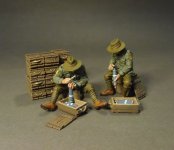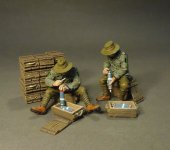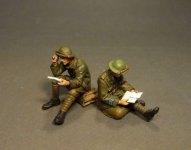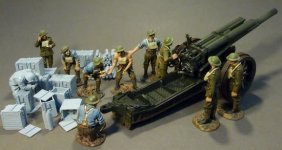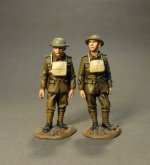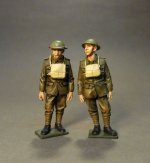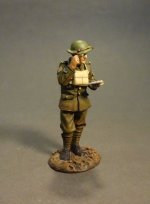THE GREAT WAR 1914-1918
THE FRENCH ARMY
World War I cost France 1,357,800 dead, 4,266,000 wounded (of whom 1.5 million were permanently maimed) and 537,000 made prisoner or missing — exactly 73% of the 8,410,000 men mobilized.
France had 40 million citizens at the start of the war; six in ten men between the ages of eighteen and twenty-eight died or were permanently maimed.
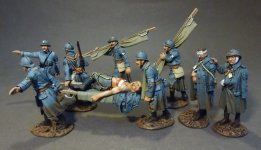
The use of horses in World War I marked a transitional period in the evolution of armed conflict. Cavalry units were initially considered essential offensive elements of a military force, but over the course of the war, the vulnerability of horses to modern machine gun and artillery fire reduced their utility on the battlefield. This paralleled the development of tanks, which would ultimately replace cavalry in shock tactics. While the perceived value of the horse in war changed dramatically, horses still played a significant role throughout the war.

GWF-36
THE GREAT WAR,1914-1918
FRENCH CAVALRY 1917-1918,
15th DRAGOON REGIMENT,
WOUNDED TROOPER,
(1pc)
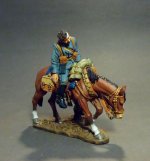
The military mainly used horses for logistical support during the war; they were better than mechanized vehicles at traveling through deep mud and over rough terrain. Horses were used for reconnaissance and for carrying messengers, as well as pulling artillery, ambulances, and supply wagons. The presence of horses often increased morale among the soldiers at the front, but the animals contributed to disease and poor sanitation in camps, caused by their manure and carcasses. The value of horses, and the increasing difficulty of replacing them, was such that by 1917 some troops were told that the loss of a horse was of greater tactical concern than the loss of a human soldier. Ultimately, the Allied blockade prevented the Central Powers from importing horses to replace those lost, which contributed to Germany's defeat. By the end of the war, even the well-supplied U.S. Army was short of horses.
THE STOKES MORTAR
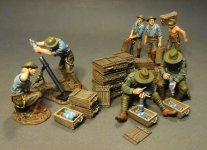
The Stokes mortar was a British trench mortar invented by Sir Wilfred Stokes KBE that was issued to the British, Commonwealth and U.S. armies, as well as the Portuguese Expeditionary Corps (CEP), during the later half of the First World War. The 3-inch trench mortar is a smooth-bore, muzzle-loading weapon for high angles of fire
The Stokes mortar was a simple weapon, consisting of a smoothbore metal tube fixed to a base plate (to absorb recoil) with a lightweight bipod mount. When a mortar bomb was dropped into the tube, an impact sensitive primer in the base of the bomb would make contact with a firing pin at the base of the tube, and detonate, firing the bomb towards the target.
The barrel is a seamless drawn-steel tube necked down at the breech or base end. To the breech end is fitted a base cap, within which is secured a firing pin protruding into the barrel. The caps at each end of the bomb cylinder were 81 mm diameter. The bomb was fitted with a modified hand grenade fuze on the front, with a perforated tube containing a propellant charge and an impact-sensitive cap at the rear.
Range was determined by the amount of propellant charge used and the angle of the barrel. A basic propellant cartridge was used for all firing, and covered short ranges. Up to four additional "rings" of propellant were used for incrementally greater ranges. See range tables below. The four rings were supplied with the cartridge and gunners discarded the rings which were not needed.

GWA-11(60)
THE GREAT WAR,1914-1918
STOKES MORTAR CREW,
(10pcs)
British Empire units had 1,636 Stokes mortars in service on the Western Front at the Armistice.
In World War I, the Stokes Mortar could fire as many as 25 bombs per minute and had a maximum range of 800 yards firing the original cylindrical unstabilised projectile. By World War II, it could fire as many as 30 bombs per minute, and had a range of over 2,500 yards with some shell types
More to follow.................................
THE FRENCH ARMY
World War I cost France 1,357,800 dead, 4,266,000 wounded (of whom 1.5 million were permanently maimed) and 537,000 made prisoner or missing — exactly 73% of the 8,410,000 men mobilized.
France had 40 million citizens at the start of the war; six in ten men between the ages of eighteen and twenty-eight died or were permanently maimed.

The use of horses in World War I marked a transitional period in the evolution of armed conflict. Cavalry units were initially considered essential offensive elements of a military force, but over the course of the war, the vulnerability of horses to modern machine gun and artillery fire reduced their utility on the battlefield. This paralleled the development of tanks, which would ultimately replace cavalry in shock tactics. While the perceived value of the horse in war changed dramatically, horses still played a significant role throughout the war.

GWF-36
THE GREAT WAR,1914-1918
FRENCH CAVALRY 1917-1918,
15th DRAGOON REGIMENT,
WOUNDED TROOPER,
(1pc)

The military mainly used horses for logistical support during the war; they were better than mechanized vehicles at traveling through deep mud and over rough terrain. Horses were used for reconnaissance and for carrying messengers, as well as pulling artillery, ambulances, and supply wagons. The presence of horses often increased morale among the soldiers at the front, but the animals contributed to disease and poor sanitation in camps, caused by their manure and carcasses. The value of horses, and the increasing difficulty of replacing them, was such that by 1917 some troops were told that the loss of a horse was of greater tactical concern than the loss of a human soldier. Ultimately, the Allied blockade prevented the Central Powers from importing horses to replace those lost, which contributed to Germany's defeat. By the end of the war, even the well-supplied U.S. Army was short of horses.
THE STOKES MORTAR

The Stokes mortar was a British trench mortar invented by Sir Wilfred Stokes KBE that was issued to the British, Commonwealth and U.S. armies, as well as the Portuguese Expeditionary Corps (CEP), during the later half of the First World War. The 3-inch trench mortar is a smooth-bore, muzzle-loading weapon for high angles of fire
The Stokes mortar was a simple weapon, consisting of a smoothbore metal tube fixed to a base plate (to absorb recoil) with a lightweight bipod mount. When a mortar bomb was dropped into the tube, an impact sensitive primer in the base of the bomb would make contact with a firing pin at the base of the tube, and detonate, firing the bomb towards the target.
The barrel is a seamless drawn-steel tube necked down at the breech or base end. To the breech end is fitted a base cap, within which is secured a firing pin protruding into the barrel. The caps at each end of the bomb cylinder were 81 mm diameter. The bomb was fitted with a modified hand grenade fuze on the front, with a perforated tube containing a propellant charge and an impact-sensitive cap at the rear.
Range was determined by the amount of propellant charge used and the angle of the barrel. A basic propellant cartridge was used for all firing, and covered short ranges. Up to four additional "rings" of propellant were used for incrementally greater ranges. See range tables below. The four rings were supplied with the cartridge and gunners discarded the rings which were not needed.

GWA-11(60)
THE GREAT WAR,1914-1918
STOKES MORTAR CREW,
(10pcs)
British Empire units had 1,636 Stokes mortars in service on the Western Front at the Armistice.
In World War I, the Stokes Mortar could fire as many as 25 bombs per minute and had a maximum range of 800 yards firing the original cylindrical unstabilised projectile. By World War II, it could fire as many as 30 bombs per minute, and had a range of over 2,500 yards with some shell types
More to follow.................................


